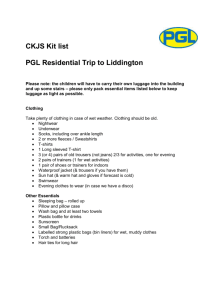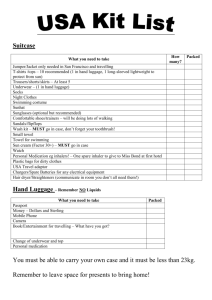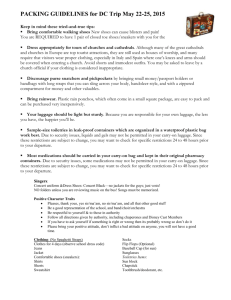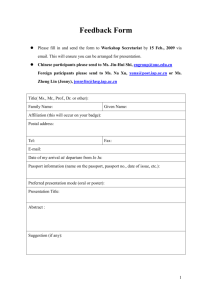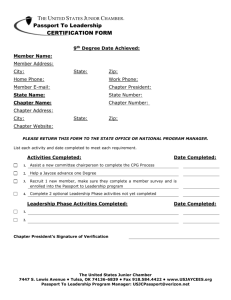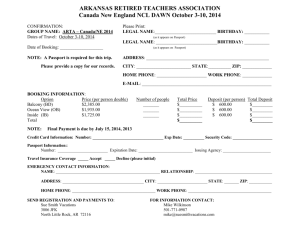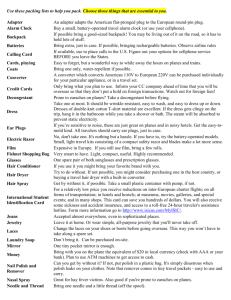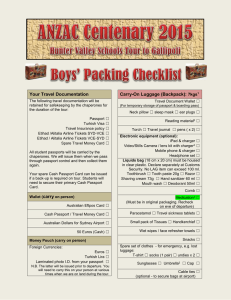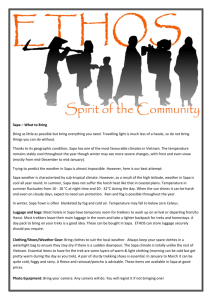Maureen`s Travel List & Tips
advertisement
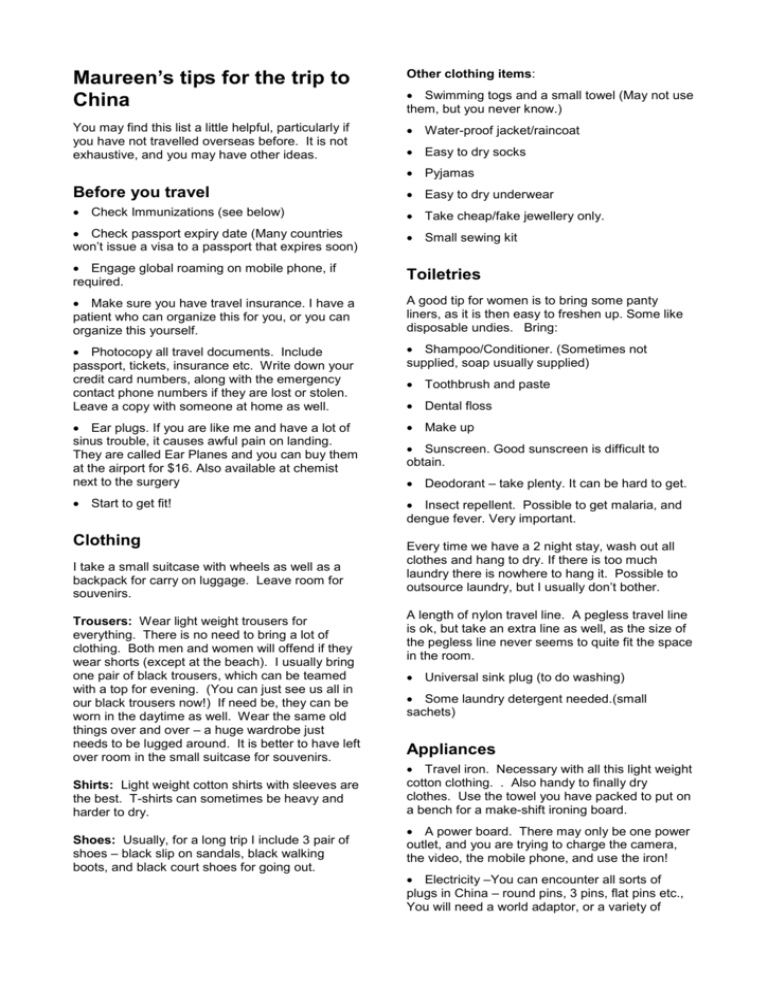
Maureen’s tips for the trip to China Other clothing items: You may find this list a little helpful, particularly if you have not travelled overseas before. It is not exhaustive, and you may have other ideas. Water-proof jacket/raincoat Swimming togs and a small towel (May not use them, but you never know.) Easy to dry socks Pyjamas Before you travel Easy to dry underwear Check Immunizations (see below) Take cheap/fake jewellery only. Check passport expiry date (Many countries won’t issue a visa to a passport that expires soon) Small sewing kit Engage global roaming on mobile phone, if required. Toiletries Make sure you have travel insurance. I have a patient who can organize this for you, or you can organize this yourself. A good tip for women is to bring some panty liners, as it is then easy to freshen up. Some like disposable undies. Bring: Photocopy all travel documents. Include passport, tickets, insurance etc. Write down your credit card numbers, along with the emergency contact phone numbers if they are lost or stolen. Leave a copy with someone at home as well. Shampoo/Conditioner. (Sometimes not supplied, soap usually supplied) Ear plugs. If you are like me and have a lot of sinus trouble, it causes awful pain on landing. They are called Ear Planes and you can buy them at the airport for $16. Also available at chemist next to the surgery Make up Start to get fit! Insect repellent. Possible to get malaria, and dengue fever. Very important. Clothing I take a small suitcase with wheels as well as a backpack for carry on luggage. Leave room for souvenirs. Trousers: Wear light weight trousers for everything. There is no need to bring a lot of clothing. Both men and women will offend if they wear shorts (except at the beach). I usually bring one pair of black trousers, which can be teamed with a top for evening. (You can just see us all in our black trousers now!) If need be, they can be worn in the daytime as well. Wear the same old things over and over – a huge wardrobe just needs to be lugged around. It is better to have left over room in the small suitcase for souvenirs. Shirts: Light weight cotton shirts with sleeves are the best. T-shirts can sometimes be heavy and harder to dry. Shoes: Usually, for a long trip I include 3 pair of shoes – black slip on sandals, black walking boots, and black court shoes for going out. Toothbrush and paste Dental floss Sunscreen. Good sunscreen is difficult to obtain. Deodorant – take plenty. It can be hard to get. Every time we have a 2 night stay, wash out all clothes and hang to dry. If there is too much laundry there is nowhere to hang it. Possible to outsource laundry, but I usually don’t bother. A length of nylon travel line. A pegless travel line is ok, but take an extra line as well, as the size of the pegless line never seems to quite fit the space in the room. Universal sink plug (to do washing) Some laundry detergent needed.(small sachets) Appliances Travel iron. Necessary with all this light weight cotton clothing. . Also handy to finally dry clothes. Use the towel you have packed to put on a bench for a make-shift ironing board. A power board. There may only be one power outlet, and you are trying to charge the camera, the video, the mobile phone, and use the iron! Electricity –You can encounter all sorts of plugs in China – round pins, 3 pins, flat pins etc., You will need a world adaptor, or a variety of adaptors. Adaptors are available at the luggage shops, Myers etc. Hepatitis B – usually given at 0, 1, and 6 months. A small torch (power can be unreliable) Hepatitis A now comes mixed with Typhoid (Vivaxim) - The typhoid then lasts 3 years. Medical Checklist Hep A given initially and again 6 months later. Prescription medicines: Also include a photocopied letter from your doctor, listing all medications you are taking. Other medicines: Malaria – we will need to take Doxycycline, Larium or Malarone. This could actually be started when we get there, as Beijing is not affected. These medications must be taken for 4 weeks after returning home. Altitude sickness. We are going very high5,500m. Going gradually in a train is helpful, but still a bit quick for many to adapt. Taking Diamox 250mg twice a day, starting when we board the train and taken for 3 days or so, advised. Have a trial run at home, in case you are allergic to it. Drink plenty of water and not too much exertion at high altitude. Thank goodness we are not mountain climbers. Rabies – just do not get bitten by a dog! Hand Luggage Try to put in a back pack which is the right size for cabin luggage – a spare change of clothes (in case luggage lost), deodorant, comb, money, credit and savings cards, all original travel documents and passport. Something to read on the plane, prescription medicines, glasses, mobile phone and charger, cameras and chargers, tissues, pens, address book. I have a great back pack which can fit on the back or be wheeled along. I take a small bum bag for coins and a little money, and mobile phone. I also use a travel pouch for around my neck with passport, credit and savings cards, and most of the money – to be worn inside shirt. Aspirin/Panadol/Ibuprofen Temaze/Stilnox to sleep on the plane Other Articles Cold and Flu tabs Photocopies of all travel documents, kept in a separate place (away from tickets, credit cards). Antihistamines Maxolon or Stemetil for nausea and vomiting Imodium for diarrhoea. (Everyone I know who travels gets diarrhoea Throat lozenges Antibiotics for travel diarrhoea – Noroxin – 6 tabs each minimum. I will take 12 tabs for myself Sunglasses Glasses and a spare pair or your prescription Padlocks (combination) for luggage. You can now get ones where you can see if they have been touched. Also secure travel tags (TamperTells). CDs for playing on the bus. Maybe 3 each. General antibiotics – ie Penicillin or an alternative if allergic. A list of your favourite jokes and short stories, to entertain on the bus Lip balm A novel or two, which we can then swap around Band aids A bandage Tweezers Scissors I am on the trip as your friend, not GP, and will have limited equipment and resources for medical treatment. Immunizations: Check on your tetanus, diphtheria and polio. If under-40, make sure you have Meningococcal vaccine. Enough film (Double what you think!) Most now go digital. Corkscrew I take a 1-2 cup coffee plunger and some ground coffee for luxury. With an in cup water heater. Blow up travel pillow Boot polish. Shoes get very dirty. Finance Some American dollars Two separate Savings accounts or 2 separate cards for ATM use. If you lose one, you can still withdraw local currency out of the other Travellers cheques are old hat. A credit card or two. Never let credit cards out of your sight! Don’t let merchants take them into a back room. Remember that tipping is the norm, and we will need to often have small amounts of change for this. Also, there will be a tip for our driver and guide, totalling around -$7 American dollars per day.
